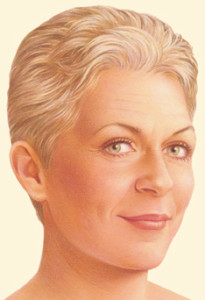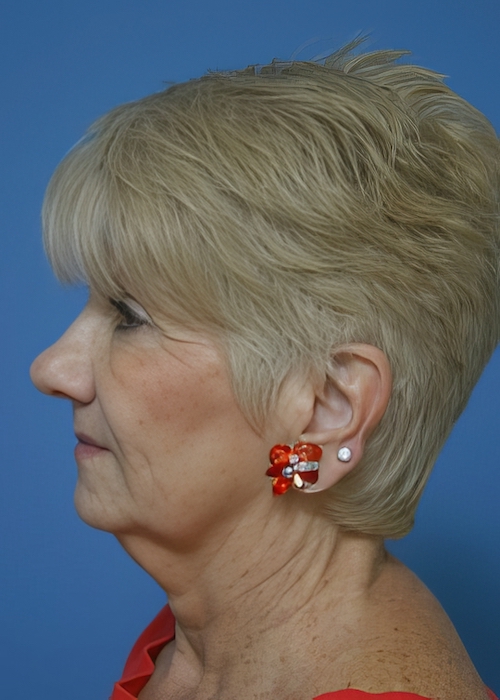Over time, the long-term effects of gravity, exposure to sun, dry air, and general stress takes its toll on an individual’s face and neckline. A facelift can considerably reduce these signs of aging. There are many kinds of facelift surgeries, from the traditional ‘skin-only’ facelifts to lunchtime facelifts to 3-D Facelifts.
What types of facelifts are there?
Facelifts can be categorized into a few different types. In general, ALL facelifts entail cutting the skin around the ears and pulling the skin of the face back to remove the excess. This can result in a smoother jawline, less fat in the neck, and an overall younger look. There is no such thing as a nonsurgical facelift.
The least invasive facelifts are usually the “lunchtime facelifts.” This category of facelifts includes suture only “Threadlifts” to one hour lifts performed under local anesthetic to quickie facelifts performed at bargain basement cosmetic surgery centers. Although each one of these is different, they all have one thing in common: THEY DON’T WORK. These shortcuts to cutting your face aren’t worth your time or money.
Most plastic surgeons perform muscle tightening facelifts called SMAS Facelifts. During this operation, the surgeon removes excess skin, repositions or suctions out unwanted fat, and tightens up drooping muscles called the SMAS and the platysma. They create scars around the ears and underneath the chin. There are several variations of these SMAS facelifts, including the SMAS-ectomy, SMAS plication, and more.
The Deep Plane Facelift is a technique first described 20 years ago and called the Composite Facelift. In this operation the plastic surgeon lifts the skin, muscle, and fat layers all together while dissecting in the “deep plane” underneath the facial muscle layer. This technique can have impressive results but with a higher risk of nerve injury.
The one-hour facelifts you see on TV are extremely misleading. These are not the revolutionary procedures they claim to be. Instead, they are simple variations of simple procedures which were proven long ago to be pretty ineffective. However, phony plastic surgeons pay thousands of dollars for ads touting these procedures as the greatest thing since the breast implant. Before-and-after photos are misleading, and don’t necessary portray the procedure that they are advertising. Most surgeons who work for these one-hour facelift centers are not even real plastic surgeons certified by the American Board of Plastic Surgery. Instead, they are doctors trained in other specialties (like ENT) who take weekend courses to learn these simple procedures. Follow-up care is often not provided. It’s a classic bait-and-switch. If you are considering one of these bargain lunchtime facelift centers, be very, very wary.
Where are the scars of a facelift?
The scars of a more traditional facelift or a mini facelift extend from the top of the ears, around the earlobe, and in the crease behind the ear. Some plastic surgeons extend the scar into the temple area, although Dr. Youn prefers not to do this. In people with very heavy necks, the scar can also extend somewhat down the hairline in the back for a better neck lift. The scars usually fade nicely with time, although all patients are at risk of a thick scar depending on how their body heals.
What Type of Facelift Does Dr. Youn Perform?
Dr. Youn performs his holistic version of a SMAS Facelift. This surgery removes excess skin and fat and tightens up the underlying muscle layer in the safest but most effective way. The surgery is based on his training in Beverly Hills and what he’s learned over the past twenty years performing nearly 1000 facelifts. The scars are kept as short as possible, and his technique creates a quick healing time, extremely low rate of complications, and fantastic and natural results. Dr. Youn’s facelift is consistent with the tenets of Holistic Plastic Surgery.
Does Dr. Youn Perform the Deep Plane Facelift?
No. Dr. Youn has studied the Deep Plane Facelift and determined that its invasiveness and potential risk of nerve injury overcome any unproven claims that it might have better results than SMAS Facelifts. This operation isn’t consistent with the Holistic Plastic Surgery tenets of getting the best results with the least invasiveness, downtime, and lowest risk of complications.
How much pain is there with a facelift?
There is usually very little discomfort with a facelift. Patients may take a few pain pills, although some patients don’t need any at all.
How long does a facelift take?
Dr. Youn’s muscle-tightening lower facelift takes approximately 3 to 4 hours to perform, depending on the amount of work to be done. Minifacelifts take closer to three hours to perform. Most patients look very presentable within 1-2 weeks. All patients have swelling which can last for 4-6 months, however.
What is the 3-D Volumetric Facelift?
Plastic surgeons used to think that a face aged in only 2 dimensions, by sagging of the skin. Hence, traditional facelift techniques treated facial aging by focusing only on tightening. This often left people looking like they were in a wind tunnel after their facelifts. We now know that the face ages in 3 dimensions, by a combination or loosening of the skin and loss of volume, mainly in the cheeks and under the eyes. The 3-D Volumetric Facelift combines a muscle-tightening facelift with volume addition using fat grafting. Therefore the neckline is tightened, but the cheeks are also softened and filled out, creating a true 3-dimensional rejuvenation. Fat is added to the cheeks, under the eyes, and even in the lips if desired. Dr. Youn coauthored a scientific paper in The Aesthetic Surgery Journal which described this technique.





